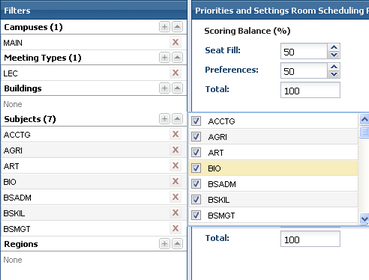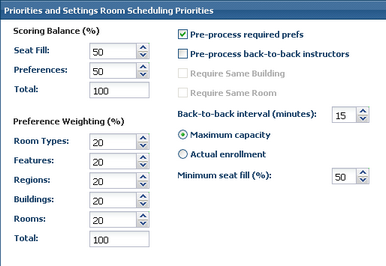Create a Room Optimizer Sandbox |

|

|

|

|
A room optimizer sandbox includes a Settings tab that saves a name for identification along with user-defined filters and other settings that dictate the scope of the assignments and the parameters applied.
To create a new room optimizer sandbox, perform the following:
1.Click the Sandboxes option on the Academics tab.
2.Click New at the top of the sandbox list.
3.Select the Room Optimization option.
4.Enter a unique sandbox file name.

5.Choose a data source.
You may choose either a production term or another sandbox as your source for sections and existing assignments to be copied and scheduled. If you choose "Production Term" you must also select a term from the drop-down list. If you choose "Sandbox" you must also select an existing sandbox file from the drop-down list.
6.Select the room scheduling preference set you would like to use to determine room preferences for this sandbox.
7.Optionally, you may choose to "Keep Existing Room Assignments". Using this option will retain any existing assignments and attempt to schedule only the remaining unassigned sections. If this option is not used, all section room assignments for included sections are dropped and re-scheduled.
Filters
Data filters that can be configured for an optimization run include Campus, Meeting Type, Building, Subject, and Region. Each of the possible filter options reduces the scope of section and/or room data considered by the optimizer. If no selections are made, all data in the selected term is considered. Using these filters allows you to be selective in choosing which sections are scheduled and into which rooms.
8.In the Filters panel, click the + button and add any data filters to define subsets of sections and/or rooms to be scheduled.
![]() NOTE: If you have created "exam" meetings for your sections and intend to optimize ONLY non-exam meetings, you MUST select all of the non-exam meeting types to be scheduled in the Meeting Type filter option.
NOTE: If you have created "exam" meetings for your sections and intend to optimize ONLY non-exam meetings, you MUST select all of the non-exam meeting types to be scheduled in the Meeting Type filter option.

Room assignments are made based on subjective and objective scheduling criteria. Astra Schedule enables you to define and modify the trade-off between your institution’s subjective and objective scheduling priorities. Scheduling priorities include seat fill efficiency and the five subjective user-defined preferences: Room Type(s), Room Feature(s), Region(s), Building(s) and Room(s). Scheduling priority settings impact the room scoring calculation and can be modified for each optimizer run.
9.In the Priorities and Settings panel, under Scoring Balance, specify a percentage for Seat Fill and for Preference to weight the scoring calculation appropriate to your scheduling needs. Placing more emphasis on Seat Fill will produce a schedule that prioritizes better enrollment to seat ratio over preference attainment. Placing more emphasis on Preference will produce a schedule that prioritizes assignments that meet academic scheduling preferences over those that fill more seats. The two percentage entries must equal 100%.

10.If you have entered a percentage for Preference under Scoring Balance, then you must also allocate a percentage to each of the five preference types. Under Preference Weighting, specify the percentage of the total allocated to Preference that should be considered for each of the individual options. Similar to the Scoring Balance section, you can influence the room scoring and assignment process by placing emphasis on specific preference types. The five entries must equal 100%.
11.Optionally select the option to "Pre-process required prefs". This option will ensure that sections with preferences marked as required will be scheduled first.
12.Optionally select the option to "Pre-process back-to-back instructors". This option will ensure that back-to-back sections with the same instructor will be scheduled first. If you choose to preprocess for back-to-back instructors, there are three possible levels:
1.If you select only "Pre-process back-to-back instructors", the system will attempt to schedule sections into the same room. If same room is not possible, same building is attempted. If same building is not possible, the sections will be scheduled elsewhere.
2.If the“Require Same Building” option is selected, the system will attempt same room, then same building, and if same building is not possible the sections are not scheduled.
3.If the “Require Same Room” option is selected, the system will attempt same room and if same room is not possible the sections are not scheduled.
If you have chosen to pre-process back-to-back instructors, you must also specify the maximum amount of time between sections (in minutes) that constitutes a back-to-back section.
![]() NOTE: When preprocessing back-to-back instructors, any "placeholder" instructor records that have been imported (i.e. "TBA" or "Staff") can interfere with these results. To avoid these types of records from being scheduled as official instructors, be sure to configure their corresponding instructor records to be ignored during optimization. To do this, edit the instructor record and remove the following flag:
NOTE: When preprocessing back-to-back instructors, any "placeholder" instructor records that have been imported (i.e. "TBA" or "Staff") can interfere with these results. To avoid these types of records from being scheduled as official instructors, be sure to configure their corresponding instructor records to be ignored during optimization. To do this, edit the instructor record and remove the following flag:
![]()
13.Select the section enrollment value you would like to use when searching for appropriately sized rooms. You may select either the section maximum enrollment or the current/actual enrollment.
14.Specify the minimum seat fill percentage that is acceptable for this optimization. The percentage entered is the minimum fill allowed for all room assignments, based on the enrollment value used and the capacity of the room.
15.Once all settings are configured as desired, click Save to save your settings and start the optimization process. The sandbox will now appear on the sandbox list with a status of “Running”. When the optimization process is finished, the status will change to “Completed” indicating that the results are ready for review.
![]()
![]() TIP: You may need to refresh the Sandbox List page to update the status field.
TIP: You may need to refresh the Sandbox List page to update the status field.
16.When the run is completed, click the name of your sandbox to view the results.
See "Review Scheduled Sections" to begin evaluating results.